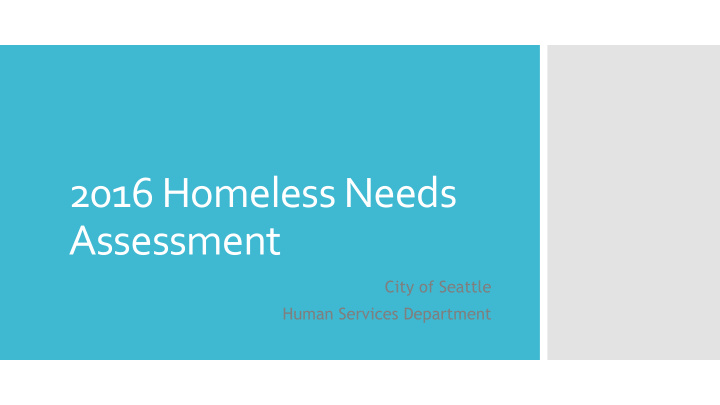



2016 Homeless Needs Assessment City of Seattle Human Services Department
More than 1,050 unique surveys with individuals experiencing homelessness in the city of Seattle in November 2016. Needs Assessment 6 targeted focus groups, held with roughly 80 individuals representing different subpopulations: Study Youth Families with children People in authorized encampments People in unsanctioned encampments People in emergency shelters People who sleep in vehicles
Who is Homeless? Where are people from? Around 70% lived in Seattle or King County when they were last C OMPARING S HELTERED AND U NSHELTERED stably housed
Why Seattle? Why did people come to Seattle? Over 50% of homeless have been in Seattle more than 5 years Looking for opportunity or because friends/family live here C OMPARING S HELTERED AND U NSHELTERED Slightly more unsheltered came for family and friends Slightly more sheltered came to access homeless services and/or VA services
Who is Homeless? Homelessness Affects Minorities Disproportionately • Latinos/Hispanics • Black/African Americans • Native Americans Slightly more Whites and Black/African Americans in shelter Slightly more Native Americans, Asians and Latinos living unsheltered
Who is Homeless? 28% of people living outdoors are 30 years or younger 28% of survey respondents identify as LGBTQ 3.4% identify as transgender
Education and Employment 41% of respondents work in some capacity (full-time, part-time, temporarily, or seasonally) 35% of respondents had some college or a college degree
Primary Event Leading to Homelessness 20% listed Housing issues as the primary event leading to their homelessness 12% were connected to LIVING ARRANGEMENTS IMMEDIATELY PRIOR TO EXPERIENCING HOMELESSNESS THIS TIME. an institution or system immediately prior to experiencing homelessness
Housing Affordability Contributes to Homelessness What would help them obtain permanent housing? 68% reported rental assistance 65% reported that an increase in affordable housing
Foster Care System Contributes to Homelessness 1 in 4 “Focus group participants, especially those in the youth foster youth experience and family groups, identified homelessness within 4 years the lack of support for youth transitioning out of foster of exiting the foster care care, combined with system. previous experiences of instability and abuse in 23% of all survey respondents reported a history of foster care. foster care homes, as causes of homelessness for this 40% of respondents under the age of 25 reported a history of foster care. vulnerable population” – Focus Strategies Needs Assessment 2017
Housing Affordability Contributes to Homelessness Rental assistance and more affordable housing were the top two responses regarding what was needed to obtain permanent housing. Over 70% of respondents could afford a monthly rent of less than $500.
Current Length of Homelessness Roughly 50% of respondents had been homeless for a year or more. 30 % were chronically homeless. 44% respondents reported they were experiencing homelessness for first time. These findings are similar to 15% meet the same definition nationally other West Coast communities Chronically homeless is defined as homeless 365 days living outside and with a disabling mental or physical condition
Drug Use Contributes to Homelessness There is a higher prevalence of drug use among people living unsheltered vs those sheltered 45% reported they do not engage in drug use 29% reported using alcohol 35% reported use of hard drugs (meth, heroin, crack) 13% reported alcohol or drug use as primary cause of homelessness 13% reported they were accessing drug or alcohol counseling services
Mental Healthcare Needs Addressing Mental Health tops List of Conditions 51% reported going to ER in past year
Large Veteran Population Remains Homeless 14% of the population were identified as veterans 55% of veterans were unsheltered Of the unsheltered, 19% were living in encampments
Domestic Violence Adds to Homelessness Among Certain Populations 42% of survey respondents reported they had an experience of Domestic Violence (DV). 5% reported it was the primary cause of their homelessness. More than half (51%) of youth 58% of female respondents reported 63% Transgender respondents who under 25 reported experiences experience with DV. of DV or abuse. reported DV 30% of males reported experience with 78% People who identified as a DV. gender other than male, female, or transgender who reported DV.
Summary of key findings
Recommend
More recommend